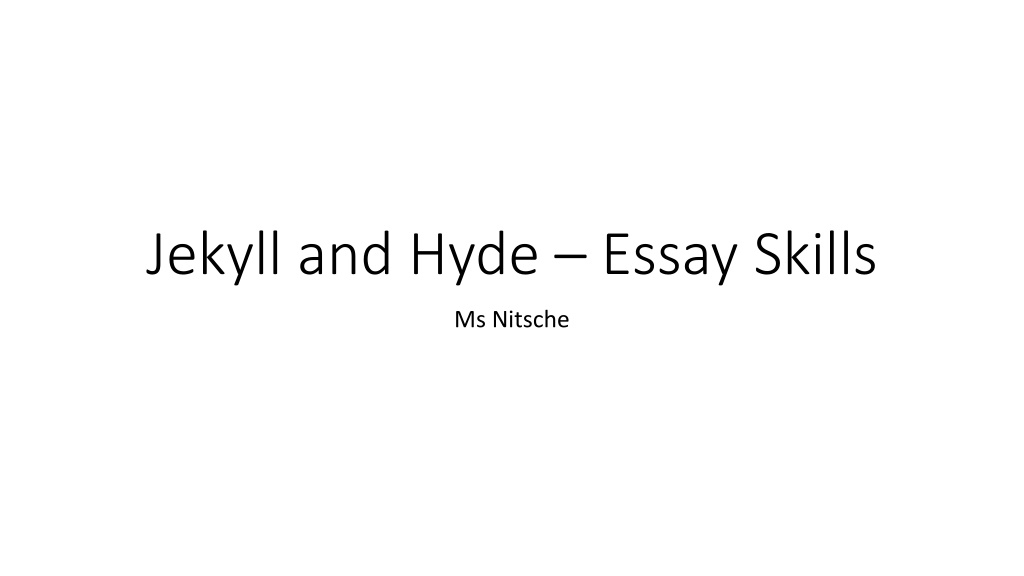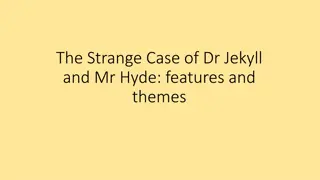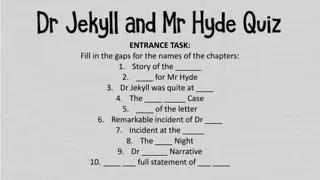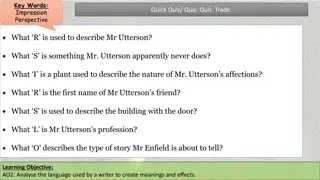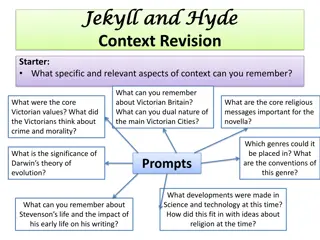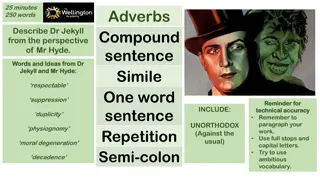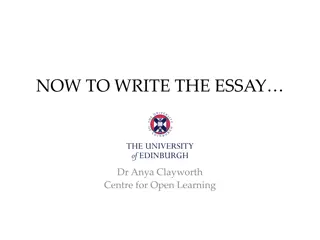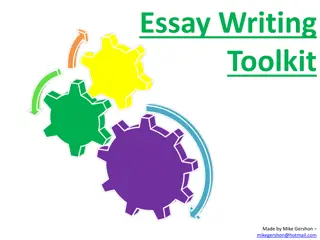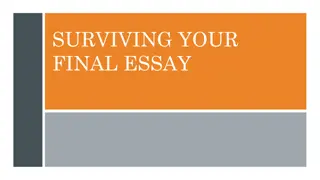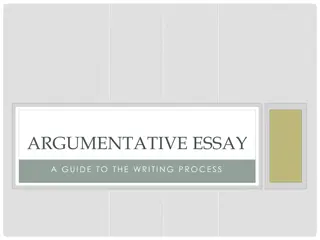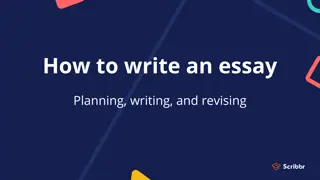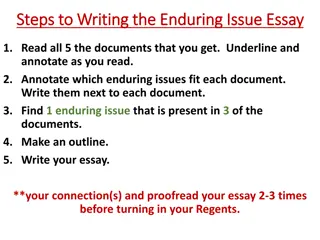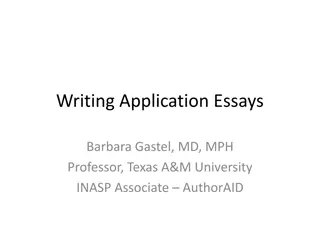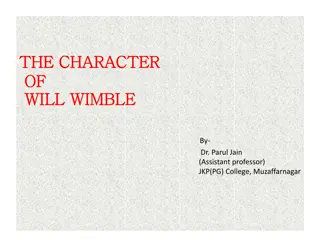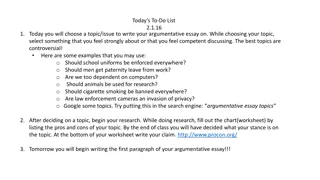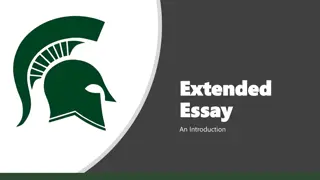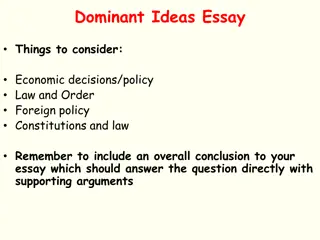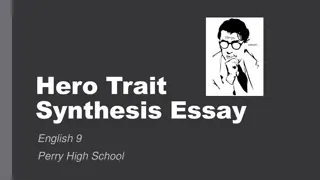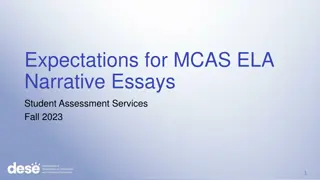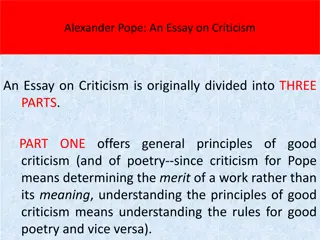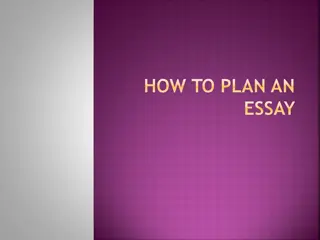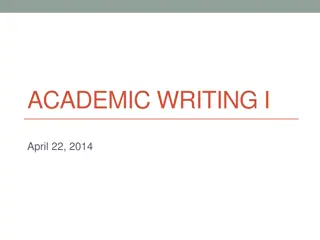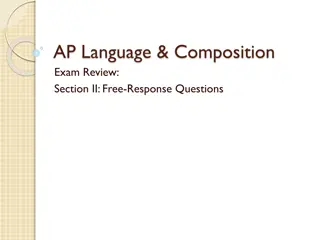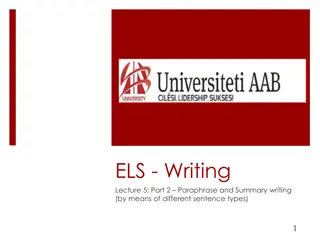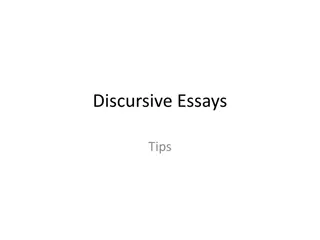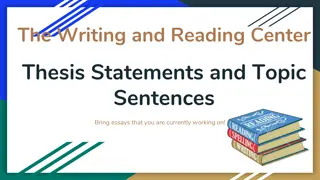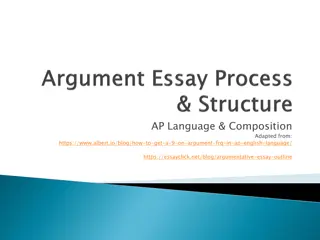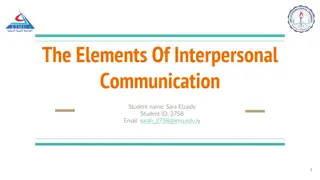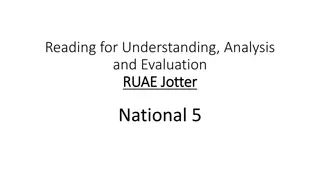Mastering Essay Skills: Jekyll and Hyde Analysis
Enhance your essay writing skills with a step-by-step guide focusing on key elements such as introduction structure, topic sentences, evidence selection, and analysis strategies using the classic tale of Jekyll and Hyde. Learn to formulate strong arguments supported by textual evidence for insightful literary analyses.
Download Presentation

Please find below an Image/Link to download the presentation.
The content on the website is provided AS IS for your information and personal use only. It may not be sold, licensed, or shared on other websites without obtaining consent from the author. Download presentation by click this link. If you encounter any issues during the download, it is possible that the publisher has removed the file from their server.
E N D
Presentation Transcript
Jekyll and Hyde Essay Skills Ms Nitsche
Introduction Start with TART (Title, Author, Refer to Task) You should also give a BRIEF outline of the story. Now, write your own introduction. YOU HAVE TEN MINUTES
Point The Point is simply what each paragraph is about- you make a main point in every paragraph you write. This is usually the TOPIC SENTENCE you use. Do not signpost your paragraph e.g. do not say I am going to talk about
What is a TOPIC SENTENCE? What is a TOPIC SENTENCE? This is basically a sentence that introduces what the paragraph is going to be about. You should mention WHAT you are going to discuss in the paragraph, and refer back to the question. REMEMBER YOUR KEY WORDS AND ALTERNATIVE LANGUAGE!
Topic Sentences All TOPIC SENTENCES should make some reference to the essay question. A good way to do this is through the KEY WORDS we extract from the essay question.
Example Topic Sentences In the novella, Stevenson effectively highlights how Jekyll s addiction to the darker side of his nature impacts his health and appearance. Stevenson s use of imagery and word choice emphasises the need for secrecy and isolation classic behaviours of addiction at our first meeting with his alter-ego, Mr Hyde.
Evidence The evidence is the quotation or description of the scene, shot or technique you are using to back up your point. It is important that you pick evidence that you can explain and evaluate FULLY. Never just drop evidence in always introduce them within the CONTEXT of the story, i.e. what is happening at this point in the story or film, what characters are involved and who they are, etc.
EXAMPLE Point (topic sentence): In our first meeting with Mr Hyde, Stevenson immediately explores the theme of addiction through his portrayal of Hyde s desperate need for isolation. Evidence (quotation): At Mr Utterson s first encounter with Hyde, it is clear he is anxious to remain in solitude. Mr Hyde shrank back with a hissing intake of breath.
Evaluation (Analysis) This is the chance for you to explain how the quotation backs up the point you are making You need to make sure that you fully explain the quotation or shot/scene/technique. You then need to evaluate it - give your opinion on how successful it is. Your opinion should be implicit - do not write I think .
1. Break the sentence down look at the meaning and connotations of individual words, techniques and phrases, as well as the whole sentence. e.g the man trampled calmly over the child s body and left her screaming on the ground. It sounds nothing to hear, but it was hellish to see. calmly suggests Hyde had no compulsions over harming the child, and contrast between this and and screaming emphasises how callous he was. Hellish not only tells us how awful a sight it was, but links Hyde s actions to something evil, or damned . 3 Steps for Analysing Quotations 3 Steps for Analysing Quotations
2. Think about what the whole sentence suggests. e.g. the man trampled calmly over the child s body and left her screaming on the ground. It sounds nothing to hear, but it was hellish to see. The sentence shows that there is no mercy in Hyde s actions, as well as highlighting the brutality of what Lanyon has witnessed. 3 Steps for Analysing Quotations 3 Steps for Analysing Quotations
3. Comment on the context of the quotation. e.g. the man trampled calmly over the child s body and left her screaming on the ground. It sounds nothing to hear, but it was hellish to see. Already we become aware of Hyde s cruelty and vicious nature, even in harming an innocent child. This brutal incident foreshadows the violence and evil that Hyde continues to wreak throughout the novel. 3 Steps for Analysing Quotations 3 Steps for Analysing Quotations
1. Break the sentence down look at the meaning and connotations of individual words, techniques and phrases, as well as the whole sentence e.g. Mr Hyde shrank back with a hissing intake of breath. shrank back suggests that Hyde fears discovery, has connotations of secrecy and hiding. hissing use of onomatopoaeia, which suggests that he is hissing in pain as though the thought of discovery is physically painful for him. 3 Steps for Analysing Quotations 3 Steps for Analysing Quotations
2. Think about what the whole sentence suggests Mr Hyde shrank back with a hissing intake of breath. e.g. This quote shows that Hyde does not want to be discovered, especially by Utterson. 3 Steps for Analysing Quotations 3 Steps for Analysing Quotations
3. Comment on the context of the quotation e.g. Mr Hyde shrank back with a hissing intake of breath. This first meeting with Hyde effectively emphasises the themes of secrecy and discovery that run throughout the novel, as well as heavily implies classic behaviours of addiction in Hyde s need to remain hidden. The painful reaction he has to discovery highlights the mysterious nature of his character, and cleverly foreshadows the pain and destruction that is still to come. 3 Steps for Analysing Quotations 3 Steps for Analysing Quotations
P - In our first meeting with Mr Hyde, Stevenson immediately explores the theme of addiction through his portrayal of Hyde s desperate need for isolation. E - Mr Hyde shrank back with a hissing intake of breath. E - shrank back suggests that Hyde fears discovery, has connotations of secrecy and hiding. - hissing onomatopoaeia, hissing in pain thought of discovery is physically painful for him. - does not want to be discovered. - emphasises themes of secrecy and discovery - classic behaviour of addiction - painful reaction mysterious - foreshadows pain still to come Example Paragraph Plan
Point (topic sentence): In our first meeting with Mr Hyde, Stevenson immediately explores the theme of addiction through his portrayal of Hyde s desperate need for isolation. Evidence (quotation): At Mr Utterson s first encounter with Hyde, it is clear he is anxious to remain in solitude. Mr Hyde shrank back with a hissing intake of breath. Evaluation (analysis): Stevenson s description of Hyde and how he shrank back suggests that Hyde fears discovery, through its connotations of secrecy and hiding. His use of onomatopoeia in hissing explores this further, inferring that he is hissing in pain as though the thought of discovery is physically painful for him. It is apparent that Hyde does not want to be discovered, especially by Utterson. This first meeting with Hyde effectively emphasises the themes of secrecy and discovery that run throughout the novel, as well as heavily implies classic behaviours of addiction in Hyde s need to remain hidden. The painful reaction he has to discovery highlights the mysterious nature of his character, and cleverly foreshadows the pain and destruction that this addiction will soon bring about. Example Paragraph
How do we write a conclusion? An effective conclusion should: Refer back to the questions. Summarise your main points. Comment on how effective the writer/director has been in their use of techniques.
